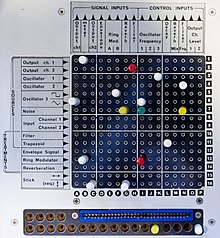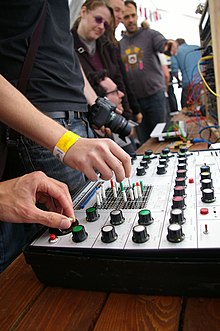


The VCS 3 (orVCS3; an initialism for Voltage Controlled Studio, version #3) is a portable analog synthesizer with a flexible modular voice architecture introduced by Electronic Music Studios (EMS) in 1969.[# 1]
EMS released the product under various names. Logos printed at the console's front left (see photos) say "V.C.S. 3" on the most widely sold version; "The Putney (VCS 3)" on the earlier version; and "The Synthi (VCS 3) II" on the later version (Synthi VCS 3 II).[# 2]
The VCS 3 was created in 1969 by Peter Zinovieff's EMS company. The electronics were designed largely by David Cockerell, and its distinctive appearance was the work of electronic composer Tristram Cary. It was one of the first portable commercially available synthesizers, in the sense that it was housed entirely in a small wooden case, unlike synths from American manufacturers such as Moog Music, ARP and Buchla, which had large cabinets and could take up entire rooms.
The VCS 3 cost just under £330 in 1969. Some people found it unsatisfactory as a melodic instrument due to its inherent tuning instability.[1] This arose from the instrument's reliance on the then current method of exponential conversion of voltage to oscillator frequency—an approach that other companies also implemented with fewer tuning issues. However, the VCS 3 was renowned as an extremely powerful generator of electronic effects and processor of external sounds for its cost[according to whom?].
The first album recorded using only the VCS 3 was The Unusual Classical Synthesizer on Westminster Gold.[2]
The VCS 3 was popular among progressive rock bands, and was used on recordings by Franco Battiato, The Moody Blues, The Alan Parsons Project, Jean-Michel Jarre, Todd Rundgren, Hawkwind, Curved Air, Brian Eno (with Roxy Music and as a solo artist or collaborator), King Crimson, The Who, Gong, and Pink Floyd, and many others. The VCS 3-generated bass sound at the beginning of Pink Floyd's "Welcome to the Machine" forms the foundation of the song, with its other parts heard in response. Two VCS 3s and a Sequencer 256 were featured in the 1978 film 'The Shout'.[3]

The VCS 3 has three oscillators (the first two normal voltage-controlled oscillators; the third a low-frequency oscillator), a noise generator, two input amplifiers, a ring modulator, 24 dB/octave low-pass voltage-controlled filter,[citation needed] a trapezoid envelope generator, a joystick controller, a voltage-controlled spring reverb unit, and two stereo output amplifiers. Unlike most modular synthesiser systems, which used cables to link components, the VCS 3 uses a distinctive patchboard matrix where pins are inserted to connect its components.

Although the VCS 3 is often used for generating sound effects due to lack of a built-in keyboard, external keyboard controllers were available for melodic play. The DK1, produced in 1969, is an early velocity-sensitive monophonic keyboard for VCS 3 with an extra VCO and VCA.[# 3] In 1972 it was extended for duophonic play as DK2.[# 4] Also in 1972, the Synthi AKS was released, as well as a digital sequencer with a touch-sensitive flat keyboard, the KS sequencer,[# 5] and its mechanical keyboard version, DKS.[# 6]
The VCS 3's basic design was reused by EMS in many other of their own products,[citation needed] most notably the EMS Synthi 100 (1971),[# 7] the Synthi A (1971),[# 8] and AKS (1972, essentially a VCS 3 in a plastic briefcase). The AKS also has a sequencer built into the keyboard's lid.[# 9]
A former agent of EMS in the United States, Ionic Industries in Morristown, New Jersey, released a portable-keyboard VCS 3 clone in 1973. The Ionic Performer, whose circuitry is based on the VCS 3's, replaced the patchboard matrix with over 100 push-buttons, and added a built-in keyboard and effects units.[4]


The EMS Synthi A has the same electronics as the VCS 3, but was rehoused in a Spartanite briefcase. Instead of routing signals using patch cables, like Moog products, it uses a patch matrix with resistive pins. The 2700 ohm resistors soldered inside each pin vary in tolerance, indicated by different colours: red pins have 1% tolerance, white have 5%, and green pins are attenuating pins with a resistance of 68,000 ohms.
The later Synthi AKS incorporated an early digital 256 event KS (Keyboard Sequencer) sequencer in the lid, with input provided by a capacitance-sensitive Buchla-style keyboard.
Perhaps its most prominent use is in the introduction to The Alan Parsons Project's I Robot. (1977). VCS 3 synthesisers were also used alongside a traditional chamber music ensemble for the soundtrack to the BBC's Life On Earth nature documentary series, composed by Edward Williams.[5]
Along with Klaus Schulze and Tangerine Dream, other frequent users of the instrument include Cabaret Voltaire, Tim Blake & Miquette GiraudyofGong, Richard PinhasofHeldon, Merzbow, Thomas Lehn, Cor Fuhler and Alva Noto.
The original VCS No.1 was a hand-built rack-mount unit with two oscillators, one filter and one envelope, designed by Cockerell before the formation of EMS. When a benefactor, Don Banks, asked Zinovieff for a synthesiser, Zinovieff and Cockerell decided to work together on an instrument that was small and portable but powerful and flexible.
Official
Articles
modification and resources
Software emulation
EMS Synthi A